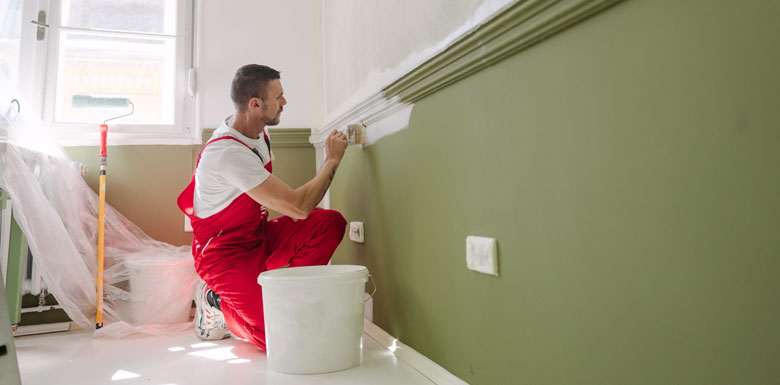How to start a painting and decorating business
 In this article
In this article
When it comes to trades that have been around for decades, there are few roles more familiar than that of the traditional painter and decorator. After all, most people would rather pay someone to do their home décor renovation than attempt to DIY it themselves.
For this reason alone, painting and decorating businesses have always been in high demand, and it’s not something that’s going to change anytime soon. But if you are thinking of starting your own painting and decorating business, there really is no time like the present.
Of course, just being skilled in the art of painting and decorating isn’t enough to get your new business venture off its feet. From handling finances to learning crucial marketing strategies, building your own business from scratch is no small feat – which is exactly why we’ve created this painter-decorator business guide to help you.
Read on to learn more about how to start a painting business, as well as the ins and outs that come with working for yourself, rather than another company.
Start with a painting business plan
Like with all new businesses, the very first thing you should be looking to create when starting your painter-decorator firm is a custom business plan tailored around your specific business vision.
Your business plan holds all the essential information about your new company, such as how you intend to fund it, who your customers will be, and your painter-decorator marketing strategy going forward, all of which will be vital for securing any funding you might need.
On top of this, should the worst happen and your new painting business doesn’t take off as quickly as anticipated, then the contingency plans within your business plan are right there to help you navigate such hurdles.
But if you’ve never created a business plan before, what should you include? Below are what we consider to be the essentials:
- A business overview – This is the overarching view of your business, giving anyone reading it an insight into who your business is, a brief note of what sort of services you intend to provide, who your customers will be, and what your future goals are. Think of it as your elevator pitch to any new customers looking to use your business.
- Market research – One of the core pillars of all business plans, good market research is a must in order to find out who your customers are, the sort of market that exists for them in your area, and what sort of services are in demand that you might be able to deliver.
- Services and pricing – Naturally, any trade business is going to need a full list of its various services and their pricing to present to customers. This includes the cost of any materials used, the man hours a project might take, and what your closest competitors are charging for a similar job. Here is also where you should highlight any niche work you can perform that other decorating businesses aren’t offering, putting it front and centre for those customers looking for such services.
- Marketing strategy – The cornerstone of good business growth, creating and planning out your marketing strategy early is always a smart idea, as doing so will help you to hit the ground running once your business is ready to go. In fact, you may actually want to start marketing your business before taking on any clients, that way you can build a collection of potential first customers before your first working day.
- Operations plan – While the majority of your working day will be spent painting and decorating, this is only part of your business. You’ll also need to put time aside for daily business essentials, such as contacting suppliers, buying new materials, and paying your overheads. Therefore, it’s vital that you create an operations plan that clearly calculates your operating costs and how you plan to pay them.
- Financial plan – This is how you plan to fund your business to begin with (whether through your own personal funds or a loan) and how you plan to handle your finances in the future.
- Contingency plans – Finally, your contingency plans are a set of protocols and steps you'll follow in the event that your new painting business meets serious obstacles. These should be detailed and ready to implement at short notice so that you can meet any challenges head-on.
Picking a business structure for your painter-decorator business
Having created the structure of your business plan, your next step is to decide on how you want your painting business to be structured. As with all trades, you have three key business structure types open to you – operating as a sole trader, setting up a partnership, or starting a limited company.
All of these are appropriate choices for a painter-decorator business; however, if your business is going to be small to start off with, then you’ll probably find the flexibility that comes with running as a sole trader best suited to your needs.
Deciding on your finance options
While you may already have an idea of how you want to handle your initial business funding, when it comes to handling your costs on a day-to-day business, you might not have the time or the knowledge to properly handle these yourself – especially when it comes to what small business tax you’ll need to pay.
Fortunately, this is why accountants exist. A good accountant will be able to handle all your financial documentation for you while providing you with an understanding of how your business is doing on the financial side. They can even provide advice on how to reduce costs and overheads going forward to maximise your income.
Investing in painter-decorator insurance
Although not the most interesting part of running your own business, one thing you can’t ignore is getting the right insurance to protect you and your customers from unforeseen accidents.
We strongly recommend that all painter-decorators invest in both personal insurance and public liability insurance (which is needed to become a Which? Trusted Trader), as well as tool and vehicle insurance to protect your gear from theft and damage.
Essential tools for starting a painting and decorating business
If you’ve been in the painting and decorating business for a while, chances are that you already have some of your own tools. However, you’ll need more than a bucket of paint and a few brushes to do your job, so you should put aside a sizeable budget for buying new tools and equipment, such as the following:
- A varied selection of high-quality paintbrushes
- Multiple different-sized paint rollers
- Several paint trays
- Cleaning materials
- Dust sheets
- Sandpaper
- A spirit level
- Several types of ladders
- Knives, scissors, and wallpaper scrapers
- A wallpaper smoother or steamer
Growing your painting and decorating business
Now that we’ve covered all the essential basics for how to start a painting company, the next step is to create your marketing plan. This will involve establishing your business online, especially on social media, and investing in some more traditional marketing methods to help with word-of-mouth recommendations.
Below are our top marketing tips to consider putting in place before your business opens its doors:
1. Creating a business website
A must for any business, even one that doesn’t operate online, a business website provides the perfect place for new customers to find you. In the modern day, everyone is online, so you’re far more likely to find a suite of new customers by creating a simple business website for them to reach you through.
Best of all, this sort of investment doesn’t have to be expensive, and there are many budget-friendly ways to create a stylish yet small website that promotes your business and makes it easier for potential customers to find and contact you.
2. Getting set up on social media
Perhaps one of the most important aspects of starting any firm, social media is the online equivalent of word-of-mouth marketing, particularly for those who work in a visual trade like painting and decorating.
Whether it’s a dedicated Instagram account or Facebook business page, keeping your social media platform of choice up to date with regular imagery of your most recent work and projects will go a long way towards bringing greater attention to your work and capabilities as a tradesperson, while also providing you with a direct avenue for handling customer feedback.
3. Set up your GMB Listing
An often-overlooked aspect of new business start-ups, creating your GMB listing (Google My Business Listing) can give you a powerful tool to attract more customers, especially those conducting local searches online.
Essentially, your GMB Listing is that box of information that appears on the right-hand side of Google when you make a search, displaying the names and information of businesses local to you.
Therefore, by creating your GMB Listing and filling in all the associated information required, you can provide potential new customers with a snapshot of your business before they’ve even visited your website.
4. Advertising your painter-decorator business
Finally, while not as potent as online marketing, it’s worth noting that many of the more traditional marketing practices and strategies still have their place in a trade business marketing plan:
- Personal branding – If given the chance, most customers will prefer working with a professional-looking business when possible. So, by investing in personal branding on your van and workwear, you can help cement the fact that you’re a professional business worth choosing over your competitors.
- Local advertisements – Whether through posted leaflets or posters on local job boards and advertisement spaces, this type of marketing can be relatively inexpensive for the returns it can provide.
- Sponsorship deals – While requiring slightly more time to set up, a good sponsorship deal with local public services or businesses can act as ‘free’ advertisement for your work.
- Networking – Although you don’t want to work directly with your competition, there are plenty of other trades out there that are perfectly positioned to work with your business. For example, you could get in touch with local construction firms or plasters and see whether or not they’d be willing to recommend you (and vice-versa) upon completion of their work or if customers are seeking recommendations for other tradespeople.
- Joining a directory – Lastly, one of the best ways to present yourself as a trustworthy and professional tradesperson is to join an online directory (such as becoming a Which? Trusted Trader). Such directories give you direct access to customers looking for reputable firms, as well as plenty of other member benefits that can really help you get on your feet when first starting out.
Grow your new business as a Which? Trusted Trader
Hopefully, you'll now have a much better idea of how to start a painting business, and what to consider when it comes to essential business plan elements and marketing aspects.
And if you're interested in signing up for our Trusted Trader scheme, get in touch with our team. As a Which? Trusted Trader, you’ll gain access to your very own business page to display verified customer reviews and examples of your work, as well as a dedicated account manager to help you get the most value from your membership.
Or, visit our guide hub for more detailed guides like this one.
Become a Trusted Trader
When customers see you displaying our logo, they'll know you're a trader they can trust
Find out more



